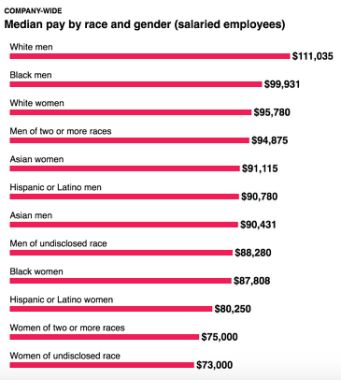Black Employees Complain of Bias at Facebook
‘Tsunami of Disinformation’ Hits Facebook Users
Black Homophobia Not the Issue, Columnists Say
New Yorker Debuts Online Documentary Fest
‘A Needless Hurt Inflicted by a President’
‘Giving Birth While Black’ Has Own Issues
Editorial Ties Tubman Film to $20 Bill
Smith’s ESPN Contract Said to Approach $8M a Year
Desiree Rogers Leads Group Buying Fashion Fair
Support Journal-isms
“The facts tell us that The Post has a problem with pay disparity. The Post has never conducted and released to the public a comprehensive pay study of its own. So this year, Post Guild decided to do one itself,” the Washington Post Guild wrote. (Credit: Melina Mara/Washington Post)
Biggest Gaps Between White Men, Women of Color
A report by the Washington Post Guild that shows a wide pay gap between white men and women of color at the Post is part of national initiative that has seen “Most employers . . . fighting back by either refusing to work with us or putting in wage increases on their own — or both,” Bernie Lunzer, president of the NewsGuild – CWA, told Journal-isms.
“Young employees of color across the newsroom don’t have complete parity with their young white colleagues,” [PDF] the report said Wednesday. “Among those under 40, newsroom employees of color make about 7 percent less than white journalists, with median salaries of $84,780 and $90,780, respectively. The disparity widens for journalists 40 and over: Newsroom employees of color have a median salary of $110,845, while their white colleagues have a median salary of $128,484 — a gap of nearly 16 percent.”
The report also said, “In the newsroom, 71 percent of salaried Guild-eligible employees are white and 24 percent of employees are nonwhite. Below are the median salaries by race and ethnicity across the newsroom:
“White: $106, 212
“Black: $97,276
“Asian: $95,205
“Hispanic or Latino: $82,890
“Two or more races: $79,860”
The Guild concluded, “The Post underpays men and women of color relative to white men. It pays white women about the median for their age.”
The report included personal testimonies. One female employee, “a 35-year-old award-winning journalist who started as an intern in the mid-2000s, recently found out that all of the men on her team are paid more than her — even though she’s been at The Post longer than all of them and has been working in journalism longer than most of them.
“One of the men on her team is paid more than $30,000 more than her. . . .”
The study found that in the newsroom:
- “Women as a group are paid less than men. . . .
- “Collectively, employees of color are paid less than white men, even when controlling for age and job description. . . .
- “The pay disparity between men and women is most pronounced among journalists under the age of 40 . . .
- “Men receive a higher percentage of merit pay raises than women, despite accounting for a smaller proportion of the newsroom.
- “The Post tends to give merit raises based on performance evaluation scores, but those who score the highest are overwhelmingly white.
- “Pay disparities have narrowed from the Graham era to the [owner Jeff] Bezos era . . .”
The company disputed the findings. “The Post is committed to paying employees fairly for the work they perform, and we believe that we do so, taking into account relevant factors like position, years of experience, and performance,” spokesperson Kristine M. Coratti said in a statement.
“It is regrettable that the Guild published a report on pay that does not appear to accurately account for these and other relevant factors, which have nothing to do with race or gender. In fact, the Guild concedes that its study’s ‘topline numbers such as median salary by gender or race and ethnicity cannot capture the entire story of pay at The Post.’ We believe the report is seriously flawed. It is disappointing that the Guild chose to issue it — The Post told the Guild before its release that we had many questions about their methodology.”
(Credit: Washington Post Guild)
The Guild has made a priority of eliminating pay gaps at least since 2016, when a similar survey at the Wall Street Journal found that female reporters earned an average of 91 cents for every dollar their male counterparts made.
The same year, the Washington-Baltimore News Guild found that white male reporters at The Post out-earn all other reporters by an average of 20 percent, and that at the New York Times, Lukas I. Alpert reported then for the Wall Street Journal, “union-represented minority employees at the Times earn 10% less than the average wage at the paper, while women are paid 7% less.”
Lunzer messaged Journal-isms Friday, “We need to do a new summary. As you know we’ve had considerable activity, especially at larger papers. We have told locals that we are requiring them to make wage info requests every time they’re headed in to bargaining and do an analysis. Part of what has helped us a lot is CWA’s willingness to do a lot of the work in-house,” referring to the Communications Workers of America.
“Most employers are fighting back by either refusing to work with us or putting in wage increases on their own — or both. I fully expect at least one new lawsuit to come from our efforts.
“Most importantly we are advocating strongly across the country for pay equity and [that] seems to be paying off. We helped with a really great presentation at NABJ and we’re working on one now for NAHJ,” referring to the National Association of Black Journalists and the National Association of Hispanic Journalists. “Both of those groups are still sometimes skittish about not wanting to ‘anger management.’ ”
The Guild made these recommendations:
- “The Post should strengthen and better formalize the salary review process. . . .
- “The Post should allow direct managers to know how much their reports make. . . .
- “The Post should ensure that pay disparities do not begin during the hiring process. . . .
- “The Post also should re-evaluate the existing two-year intern program. . . .
- “The Post must do more to ensure that the company reflects the diversity of American society. . . .
- “To hold the company accountable in creating an equitable and diverse workplace, we also recommend that The Post hire an equity, diversity and inclusion chair/consultant and form a diversity committee. . . . ” It has had diversity committees in the past.
- Andrew Beaujon, Washingtonian: A Massive New Study Says the Washington Post Often Underpays Young Women and People of Color
- Christine Schmidt, Nieman Lab: Washington Post’s union finds that women and people of color in the newsroom make less
Micro-targeted data intended for advertising on social media are being used to to change power structures globally, says Philippine journalist Maria Ressa. (video) (Credit: Joy Sharon Yi/Washington Post)
Black Employees Complain of Bias at Facebook
“An anonymous memo alleging Facebook still has a problem with racial bias is circulating inside the company one year after a former employee complained of racism and discrimination there,” Jessica Guynn reported Friday, updated Saturday, for USA Today,
“The Medium post from 12 current and former employees, first reported by Business Insider, details a number of incidents, suggesting morale has sunk even lower since Mark Luckie published his Facebook post about discrimination on the company’s Silicon Valley campus and on the social media giant’s platform.
“Both missives expose the racial fault lines in the mostly white tech industry and how the stubbornly persistent lack of representation and agency of African-Americans inside Facebook directly affects how black people on Facebook and its other platforms are treated.
“ ‘We may be smiling. We may post on Instagram with industry influencers and celebrities. We may use the IG “Share Black Stories” filter and be featured on marketing pieces. We may embrace each other and share how happy we are to have the opportunity to work with a company that impacts nearly three billion people,’ the anonymous memo says. ‘On the inside, we are sad. Angry. Oppressed. Depressed. And treated every day through the micro and macro aggressions as if we do not belong here.’ . . . ”
‘Tsunami of Disinformation’ Hits Facebook Users
“A year out from the 2020 presidential election, a flood of fake news is already consuming Facebook, with U.S. voters hit with a ‘tsunami of disinformation’ in the last three months,” David Gilbert reported Wednesday for Vice. “But unlike in 2016, this fake news is not coming from Russia, but from within the U.S.
“Researchers at Avaaz, a non-profit human rights activism network, say they have so far found no evidence of coordinated disinformation campaigns from foreign actors — but even without these campaigns, Facebook users in the U.S. are being overwhelmed by misleading content.
“ ‘Politically relevant disinformation was found to have reached over 158 million estimated views, enough to reach every reported registered voter in the U.S. at least once,’ the report published on Wednesday morning said.
“That disinformation could influence the outcome of the 2020 election is hardly surprising, but ‘what is surprising is that the surge of disinformation affecting 2020 is happening much earlier than the 2016 election,’ Luca Nicotra, a senior campaigner with Avaaz, told VICE News.”
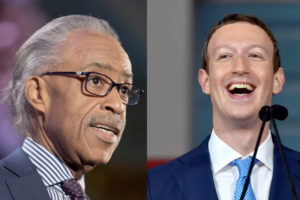 On Monday, Al Sharpton, president of the National Action Network, and leaders from about 10 civil rights groups dined with Facebook co-founder and CEO Mark Zuckerberg and warned him that politicians might try to suppress the vote by spreading misinformation during upcoming elections and the 2020 Census. They challenged Facebook’s decision to exempt politicians’ ads from fact-checking.
On Monday, Al Sharpton, president of the National Action Network, and leaders from about 10 civil rights groups dined with Facebook co-founder and CEO Mark Zuckerberg and warned him that politicians might try to suppress the vote by spreading misinformation during upcoming elections and the 2020 Census. They challenged Facebook’s decision to exempt politicians’ ads from fact-checking.
Vice’s Gilbert also wrote of the Avaaz study, “Almost all of the fake news observed by the researchers was negative in nature, with 62 percent attacking Democrats and 29 percent against Republicans. The remaining 9 percent of the disinformation stories in the sample were ‘positive,’ and all of them were pro-Republicans/Conservatives. . . .”
- Hiawatha Bray, Boston Globe: For TikTok, the clock is ticking. Why not for Facebook, Google, and Twitter?
- Yaël Eisenstat, Washington Post: I worked on political ads at Facebook. They profit by manipulating us.
- David Gilbert, Vice: Facebook Has Become a ‘Megaphone for Hate’ Against Muslims in India (Oct. 29)
- Ryan Grim, the Intercept: A Facebook Ban on Political Ads Would Be a Major Blow to the Left. Just Look at AOC’s Campaign.
- Danielle Moodie-Mills, Zora/medium.com: The Congresswomen of Color Gave Mark Zuckerberg the Reproach He Deserved (Oct. 31)
- Donie O’Sullivan, CNN: Searching for Google and YouTube in Big Tech’s political ad controversy
- Laura Hazard Owen, Nieman Lab: It is still incredibly easy to share (and see) known fake news about politics on Facebook
- Leonard Pitts Jr., Miami Herald: Twitter won’t let politicians lie. But there are too many other places where they can
- Radio Ink: iHeart’s Plan To Go After Google And Facebook Revenue
- Nancy Scola, Politico: Facebook considering limits on targeted campaign ads
- Emily Stewart, vox.com: Twitter chose to ban political ads. But pressuring Facebook to do the same could backfire.
- S.C. Stuart, PC: Tech History Is More Than Just ‘White, Male Wizards’ (Oct 31)
- Ellen L. Weintraub, Federal Election Commission chair, Washington Post: Don’t abolish political ads on social media. Stop microtargeting.
Black Homophobia Not the Issue, Columnists Say
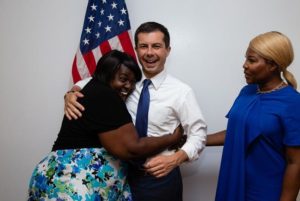
Some mainstream black columnists, including two who self-identify as gay, are pushing back on the notion that African Americans will not vote for South Bend, Ind., Mayor Pete Buttigieg because of his sexual orientation.
“Internal focus groups conducted by Pete Buttigieg’s presidential campaign this summer reveal a possible reason why he is struggling with African-American voters: some see his sexuality as a problem,” David Catanese reported Oct. 22 for McClatchy.
“The 21-page report, conducted by the Benenson Strategy Group with black Democratic South Carolina voters in mid-July and obtained exclusively by McClatchy, found that ‘being gay was a barrier for these voters, particularly for the men who seemed deeply uncomfortable even discussing it. … [T]heir preference is for his sexuality to not be front and center.’ . . .”
“Yes, Buttigieg’s sexuality and his marriage to his husband, Chasten, may be a problem for some voters, regardless of their race,” Renée Graham wrote Tuesday in the Boston Globe. “Yet the greater barrier for the young mayor in garnering African-American support is likely his weak record on civil rights, racial inclusion, and police accountability. . . .”
Graham also wrote, “Because America never learns when it comes to racism, this is reminiscent of the ignorance peddled by Dan Savage, a gay columnist, in 2008. When California’s Proposition 8 outlawing gay marriage passed that year, Savage falsely claimed black people, who flocked to polls to elect the first black president, were to blame.
“ ‘I’m done pretending that the handful of racist gay white men out there . . . are a bigger problem for African-Americans, gay and straight, than the huge numbers of homophobic African-Americans are for gay Americans, whatever their color,’ Savage wrote in a column titled ‘Black Homophobia.’ (That piece seemed to have been scrubbed, but since the Internet never forgets, its most inflammatory quotes live on in cyber perpetuity.)
“As a member of the LGBTQ community, let me just say there are way more than a ‘handful of racist gay white men out there,’ and that I’ve faced far more racism from them than I’ve faced homophobia in the black community. . . .”
Others weighing in include Jonathan Capehart of the Washington Post and Charles M. Blow of the New York Times.
“As a black man and gay man, it’s time that I respond to a talking point making the rounds that African Americans are homophobic and, therefore, won’t vote for Pete Buttigieg,” Capehart wrote Friday under the headline, “The ugly lie about black voters and Pete Buttigieg.”
Blow wrote, “Reducing Pete Buttigieg’s struggle to attract black support solely to black homophobia is not only erroneous, it is a disgusting, racist trope, secretly nursed and insidiously whispered by white liberals with contempt for the very black people they court and need. . . .”
- Michael Gryboski, Christian Post: Are black Democrats less likely to vote for Mayor Pete because he’s gay?
- Suzette Hackney, Indianapolis Star: Poll says America isn’t ready for a gay president like Buttigieg. Who cares? (Nov. 1)
New Yorker Debuts Online Documentary Fest
“Lazarus,” directed by David Darg and produced by Bryn Mooser, follows Lazarus Chigwandali on his rise from Malawian street musician to global recording artist and human-rights activist, who is bringing attention to people with albinism. It is part of “The New Yorker Documentary,” “a video series showcasing true, human stories, both long and short, told in innovative ways,” according to the magazine.
“The series features a wide array of films, produced by filmmakers who are drawn to topics that define a particular time or place — from a funeral director confronting H.I.V./AIDS in his community, to a human-rights activist battling the stigma of albinism, to a young girl fleeing violence in Guatemala. . . .”
The series debuted on newyorker.com last month.
Beginning on the day after Veteran’s Day this year, a group of veterans and their supporters will walk across the Pine Ridge Reservation. #NativeVeterans #NativeAmericanHeritageMonth #NativeAmerican https://t.co/g8r5SrNk4V
— indianz.com (@indianz) November 6, 2019
‘A Needless Hurt Inflicted by a President’
“Native Americans and others gathered recently at what has become a joyous annual ritual for the native community — the Twin Cities E.A.T.S.S. event that celebrates indigenous cuisine and raises awareness for the American Indian College Fund,” the Star Tribune in Minneapolis editorialized on Friday. “As this year’s patrons settled in with smoked bison and dishes flavored with cedar and juniper, listening to stories of achievement by young Indian students heading to careers in law, medicine and other fields, there was only one downbeat note.
“In announcing the program, the moderator said that historically, November has been recognized as National Native American Heritage Month, a source of pride in that community. This year, she said, President Donald Trump had also pronounced November to be the first National American History and Founders Month. In that proclamation, no mention was made of the previous 15,000 years of history by this land’s first inhabitants.
“A momentary pall fell over the room. No angry outbursts, just a lot of grimaces acknowledging yet another wound.
“This was a needless hurt inflicted by a president who so often seems to find a way to do just that. He had already renewed the Native American proclamation, as has every president before him since 1990. How cruel then, to force Native Americans to share even that small gesture with those responsible for taking their land and for all the atrocities that followed. . . .’
- Teo Armus, Washington Post: November is Native American Heritage Month. Critics say Trump is subverting it with a new celebration of the Founding Fathers.
- Aliyah Chavez, Indian Country Today: Indigenizing research institutions’: Two journalists honored by The American Academy
- Rob Mentzer, Wisconsin Public Radio: Paul DeMain Gave Voice To Native American Issues. Now He’s Ready For His Next Chapter.
- Max Nesterak, American Public Media: Uprooted: The 1950s plan to erase Indian Country

“Though she had an enviably easy pregnancy, what followed was the greatest medical ordeal of a life that has been punctuated by them,” Rob Haskell wrote the next year in Vogue about Serena Williams’ 2017 delivery. “Olympia was born by emergency C-section after her heart rate dove dangerously low during contractions. The surgery went off without a hitch; Alexis cut the cord, and the wailing newborn fell silent the moment she was laid on her mother’s chest. ‘That was an amazing feeling,’ Serena remembers. ‘And then everything went bad.’ . . .”
‘Giving Birth While Black’ Has Own Issues
“Black people are three and a half times more likely to die in childbirth than white people,” begins the description for “Learning to Listen to Patients,” a 17-minute segment of the University of Virginia public radio show “With Good Reason.” “Even highly educated, wealthy African Americans are at a greater risk of complications than whites. To combat the disparity, Dr. Rochanda Mitchell promotes hiring more African American nurse educators and providing anti-bias training for medical professionals.”
Other segments on the show devoted to “Giving Birth While Black”: “Bellamy Shoffner was well aware of the frightening statistics when she gave birth to her sons. Shoffner is Founder and Editor of Hold The Line Magazine, about social justice motherhood.”
And: “Although doulas have become more popular, they’re still expensive and often unavailable for high risk populations. Christin Farmer created Birthing Beautiful Communities, a non-profit that trains and provides doulas at no cost to African Americans in Cleveland, Ohio.”
Editorial Ties Tubman Film to $20 Bill
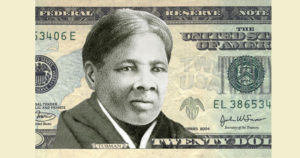 According to the New York Times, this is an early prototype of the Harriet Tubman version of the $20 bill.
According to the New York Times, this is an early prototype of the Harriet Tubman version of the $20 bill.
“It’s easy to look back on American history and cast aspersions. But it’s harder to recognize the complexity and uneven nature of history,” the Dallas Morning News editorialized on Nov. 3.
“There are American heroes who dedicated — and risked — their lives forcing this nation to live up to its best ideals of human liberty.
“Harriet Tubman was one such woman.
“It’s one thing to talk about the basic principles that we all should follow: That all human beings deserve to be free to live their lives as they see fit. That we all should be afforded the rich opportunities this country has to offer.
“It’s quite another to have the courage to fight for them for ourselves and for others.
“There is no better example than Tubman. We’re particularly pleased that a new generation will get to learn about her bravery and perseverance with the movie Harriet that opened on Friday. . . .”
The editorial also said, “It’s not lost on us that this movie opens just months after the Trump administration announced that a planned redesign of the $20 bill that would replace the image of President Andrew Jackson with Tubman’s has been postponed until 2026. It was originally slated for next year, but the Treasury Department said it is delayed because of a focus on counterfeiting measures.
“We see it as a frustrating missed opportunity to honor a giant in our history. We urge Congress to restore a sense of urgency with this effort.
“Maybe lawmakers should take an hour-long field trip from D.C. to the Harriet Tubman Underground Railroad National Historical Park on the Eastern Shore of Maryland to remind themselves of her importance. It opened in 2017 and includes a 125-mile memorial drive through key locations along the Underground Railroad. . . .”
Meanwhile, noting that Tubman is played in the movie by Cynthia Erivo, a black British woman, Farah Stockman wrote Friday in the New York Times that “A spirited debate is playing out in black communities across America over the degree to which identity ought to be defined by African heritage — or whether ancestral links to slavery are what should count most of all. . . .”
- Richard Brody, New Yorker: The Stunning Achievement of Kasi Lemmons’s “Harriet” (Oct. 30)
- DeNeen L. Brown, Washington Post: A new Harriet Tubman movie also stars the places where the Underground Railroad leader made history
- Taryn Finley, HuffPost: Gentrification Comes For Harriet Tubman House (Oct. 3)
- Lisa Respers France, CNN: ‘Harriet’ controversies didn’t stop box office success
- Soraya Nadia McDonald, the Undefeated: ‘Harriet’ falls prey to the dignity paradox
- Tony Norman, Pittsburgh Post-Gazette: An icon, a gun and American history’s blank slate (Nov. 1)
- Katy Reckdahl, NOLA.com: ‘Heartbreaking’ but ’empowering’: Re-enactors recall doomed 1811 slave revolt in Louisiana
- Katy Reckdahl, NOLA.com: At Metairie ‘Harriet’ screening, ticket dispute leads to racial profiling investigation
- Diane Stopyra, Philadelphia Inquirer: Cape May is banding together to build a museum for Harriet Tubman, who used the island as an Underground Railroad headquarters
I said it years ago. I say it now. I will forever say this: pic.twitter.com/8yO9VxJz8T
— Stephen A Smith (@stephenasmith) November 8, 2019
Smith’s ESPN Contract Said to Approach $8M a Year
“Stephen A. Smith’s new five-year contract will make him ESPN’s highest-paid sportscaster with an annual salary that will approach $8 million per year, according to sources,” Andrew Marchand reported Thursday for the New York Post.
“This will move Smith past Mike Greenberg’s $6.5 million, which was ESPN’s previous known highest salary. Greenberg is the host of ‘Get Up!’
“When The Post first reported negotiations between Smith and ESPN in April, some in the industry felt Smith might be able to negotiate a $10 million annual salary.
“Smith got nearly $8 million, but he received some money upfront, making it more worth his while to re-up with a year left on his current deal.
“Smith will continue to be front and center on ESPN’s air with his daily morning show ‘First Take,’ as well as on ‘SportsCenter’ and the network’s NBA coverage. Though the finer points of the contract are not fully completed, Smith has already started hosting Wednesday’s ‘SportsCenter’ leading into ESPN’s NBA schedule that night. . . .”
Desiree Rogers Leads Group Buying Fashion Fair
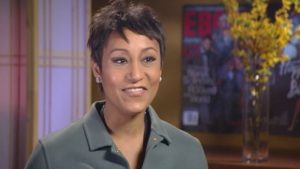
“Fashion Fair, once the largest black-owned cosmetics company in the world and a brand developed by Johnson Publishing Co., has been sold to investors that include Chicago business leader Desiree Rogers,” David Roeder reported Thursday for the Chicago Sun-Times.
“Rogers and Cheryl Mayberry McKissack, who were Johnson Publishing executives, will be majority owners of Fashion Fair. Hedge fund operator Alec Litowicz will hold a minority stake as a personal investment and not through this company, Evanston-based Magnetar Capital, the buyers said.
“The sale was approved Thursday in U.S. Bankruptcy Court as part of the Chapter 7 liquidation of Johnson Publishing assets.
“The same investors own the Black Opal line of skin-care and beauty products. Fashion Fair sold for $1.85 million, said a spokesman for Hilco Streambank, the firm that advised the bankruptcy trustee handling the sale.
“ ‘Fashion Fair is just too valuable for our community to lose,’ Rogers said. ‘We plan to modernize the brand and products, but will remain true to the company’s roots, which was to create prestige products focused on women of color.’
“The late Eunice W. Johnson created Fashion Fair in 1973, when few cosmetics companies developed products for people with darker skin tones. It grew from offering limited products, called a capsule collection, to a full line that was available in high-end department stores. . . .”
Short Takes
- “Two hundred employees were paid, but 58 showed up for work. Crane operators invoiced without having set foot on the island. An unqualified lineman earned almost $58,000 for a month-and-a-half of work, which is what a Puerto Rico Electric Power Authority (PREPA) lineman charges in a year and five months,” Víctor Rodríguez Velázquez and Vanessa Colón Almenas reported Wednesday for periodismoinvestigativo.com. They also wrote, “These are some of the irregularities revealed in an audit of the U.S. Department of Defense’s Office of the Inspector General on the repair and restoration of Puerto Rico’s power grid after Hurricane María and that could have added up to $50.1 million in federal funds. . . .”
- “Non-profit organisation The Save Journalism Project has launched a crowdfunding campaign to pay laid-off reporters in the US to write about mass job losses in the media industry,” Daniel Green wrote Friday for Britain’s journalism.co.uk. “The Freelance Reporting Initiative will produce five stories from the campaign looking into the impact closing news titles has had on local communities and the effects of the continual digital growth of Facebook and Google on the industry. . . .”
- “The Society of Professional Journalists and 28 more journalism and open government groups sent a letter today to every member of Congress calling for support of unimpeded communication with journalists for all federal employees,” SPJ announced Wednesday. “Not allowing experts to speak freely to reporters is authoritarian and keeps sources from explaining a variety of things that are the public’s business,” the groups say in the letter. The National Association of Black Journalists was among the signatories.
- “The country’s leading newspaper union issued a scathing analysis of the proposed Gannett-GateHouse merger Friday, saying the deal would drive down wages and employment for journalists at the 250 daily newspapers and hundreds of weekly and community papers the combined companies would own, and would overcompensate GateHouse’s private equity backers,” Jonathan O’Connell reported for the Washington Post.
- “It’s the end of an era,” Leah Asmelash reported Friday for CNN. “ABC’s beloved comedy, ‘Fresh Off the Boat,’ is coming to an end. The show will end February 21 with an hour-long finale to season six — which is currently airing. The show’s exit leaves a gaping hole in network television. It was one of the only shows prominently featuring an Asian-American family, and was heralded during its debut in 2015 for being one of the first to bring a long under-represented group to Hollywood’s small screen. . . . “
- “Award-winning radio host Joe Madison, who this year was named one of the nation’s 10 most important hosts by Talkers magazine, is among the eight 2019 inductees into the National Radio Hall of Fame,” the Washington Informer reported Friday. This year’s inductees are: Sean “Hollywood” Hamilton, Harry Harrison, Kevin Ryder and Gene “Bean” Baxter (Kevin & Bean), Joe Madison, Jim Rome, Ryan Seacrest, John Tesh, and Dr. Ruth Westheimer.

Frances Wang, before and after (Courtesy Frances Wang via Miami Herald)
- “Frances Wang is returning to a TV near you this week after going off the air for a month to recover from a painful skin condition she’s been battling for nearly six months,” Michelle Marchante reported Tuesday for the Miami Herald, updated Wednesday. “The anchor and reporter was diagnosed with perioral dermatitis only a few months after moving to South Florida for her new job at WFOR-CBS4. . . .”
- “College Behind Bars” debuts on PBS Nov. 25 and 26, Christopher Norris reported Friday for Philadelphia’s WHYY.org. The program focuses on the Bard Prison Initiative, which gives inmates access to the liberal arts curriculum taught at Bard College, a private, nonprofit school overlooking the Hudson River. Graduates of BPI, a program in six New York state prisons, are likely to garner resentment, Norris reports, though Lynn Novick, the film’s director, says the relevant question is, “How do we want to deal with the fact that 95% of people who are incarcerated are coming home?”
- Working hard to report the complex daily realities of prison life for their fellow prisoners and the outside world is a small press corps of prisoners who work across a variety of media to inform, entertain, and keep the record straight, Al Jazeera reported on Nov. 2. “While most report almost exclusively for their fellow prisoners, some, like Esquire contributing editor, John J Lennon — who is currently serving 28 years to life at Sing Sing Correctional Facility in New York State — build devoted audiences far beyond prison walls. They toe a delicate line, striving to tell the truth as best they can without alienating prison authorities, or releasing information that could harm their fellow prisoners. . . .”
- Jim MacMillan, a former Philadelphia Daily News photographer, first noticed subtle disparities in the way whites and people of color were covered while working at the newspaper, Jenice Armstrong, columnist for the Philadelphia Inquirer and Daily News, wrote Friday. “ ‘Back in the ’90s, I covered a lot of gun violence in Philadelphia, and various editors would say things to me, ‘This isn’t news.’ Or, ‘Nobody cares because it’s just a drug dealer,’ MacMillan, 58, recalled. . . .” Armstrong also wrote, “That’s why MacMillan organized Friday’s Initiative for Better Gun Violence Reporting Summit at WHYY. The gathering, which attracted reporters from as far away as Chicago and Los Angeles, was about trying to find the best ways to cover this insidious epidemic. . . .”
- “Journalism groups and media organizations are launching a new campaign called ‘Protect Press Freedom,’ including a one-minute spot that will air on networks and broadcast stations. Watch it above,” Ted Johnson wrote Thursday for Deadline. He also wrote, “The campaign is spearheaded by the Reporters Committee for the Freedom of the Press and the Committee to Protect Journalists, along with Free Press, Internews, Media Law Resource Center, PEN America, Reporters Without Borders and the Society of Professional Journalists. They are partnering with 30 media and technology firms and other nonprofits. . . .”
- Kansas City voters overwhelmingly decided Tuesday to remove Martin Luther King Jr.’s name from The Paseo, a major north–south parkway. The Kansas City Star editorialized Wednesday, “Renaming The Paseo for Martin Luther King Jr. would not have solved those problems, but it would have been the start of an important healing period. Kansas Citians must make sure that we have a chance to make progress on that front, even in the wake of Tuesday’s outcome at the polls. They can do that by taking a thoughtful approach to identifying a positive alternative to honor King in Kansas City. . . .”
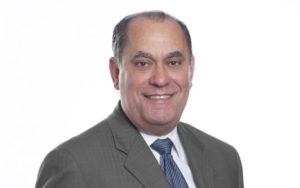
- “NBCUniversal Owned Television Stations today appointed Jorge Carballo, the current president-GM of WSCV Miami (Telemundo 51) to also oversee operations of NBC O&O WTVJ, effective Jan. 1, 2020,” Mark K. Miller reported Friday for TVNewsCheck.
- Student activists at Harvard University want the Harvard Crimson, the campus newspaper, to stop seeking comment from U.S. Immigration and Customs Enforcement, Callum Borchers wrote Tuesday for Boston’s WBUR radio. Change.org, demanding an apology from the Crimson and citing potential harm to the undocumented, said, “In this political climate, a request for comment is virtually the same as tipping them off, regardless of how they are contacted.” The Hatchet at George Washington University defended the Crimson in an editorial Monday. “Harvard University students didn’t get the common journalistic memo late last month when they condemned The Crimson for asking Immigration and Customs Enforcement to comment on a protest calling on the organization to dissolve. Students are taking a stand for all the wrong reasons. . . .”
- Leaders of the Philadelphia Association of Black Journalists Wednesday formally protested the National Association of Black Journalists’ Executive Board’s failure to select Philadelphia for its 2023 and 2025 conventions. NABJ President Dorothy Tucker, in an explanation on the NABJ website, replied Thursday, “Despite our love for the Philadelphia chapter, it would not have been a good business decision to choose the city. . . .” The NABJ board announced Oct. 31 it had chosen Birmingham, Ala., for 2023, Chicago for 2024, Cleveland in 2025 and Atlanta in 2026. Previously announced were Washington in 2020 (with the National Association of Hispanic Journalists), Houston in 2021 and Las Vegas in 2022.
- “The Philadelphia Association of Black Journalists (PABJ) got its largest grant ever this past weekend,” John N. Mitchell wrote Monday for the Philadelphia Tribune. “The Lenfest Institute for Journalism presented the PABJ with a $50,000 grant Saturday night during the organization’s annual Awards and Scholarship Gala held at the studios of WHYY.” Asked where the money will go, PABJ President Manuel McDonnell Smith said, “We have been having conversations around how we can support Black journalists, encourage their entrepreneurial endeavors and push beyond traditional journalism.”
- “Rep. Bobby Rush (D-Ill.) has taken aim at Comcast in a stinging letter to the company’s chairman,” John Eggerton reported Friday for Multichannel News. “In a letter to Comcast CEO Brian Roberts, Rush excoriates the company for challenging a court decision reinstating a suit against Comcast for allegedly discriminating in its noncarriage of networks. That comes as the Supreme Court prepares to hear Comcast’s appeal (oral argument is Nov. 13) of a 2015 discrimination suit brought by Entertainment Studio’s chief Byron Allen that alleged Comcast conspired to keep African-American owned networks off its cable systems. . . .”
- In an Editor & Publisher “Photo of the Month,” graduating pre-K student Kyle Johnson receives a hand from his father, Loushen Johnson, while walking to accept his diploma on stage at the Family Centers Head Start preschool graduation ceremony in Greenwich, Conn., in June. (Credit: Tyler Sizemore/Hearst Connecticut Media)
- “Pro Football Hall of Famer Cris Carter is out at Fox Sports, where he was the co-host of Fox Sports 1’s morning debate show, ‘First Things First,’ ” Tim Baysinger reported Thursday for the Wrap. ” ‘Cris Carter is no longer with Fox Sports,’ said Fox Sports in a statement. ‘There is no further comment at this time.’ Carter has not appeared on the Fox Sports 1 morning show since Oct. 30. The Big Lead reported on Sunday that Carter had been suspended from Fox following an investigation, though the nature of that investigation was not known. . . .”
- “World [Wrestling] Entertainment is . . . in the middle of a he said/they said dispute with Jordan Myles,” Carron J. Phillips reported Nov. 1 for the Shadow League. “The black pro wrestler on WWE’s NXT circuit is accusing the company of making a racist shirt with his name on it that resembles the Sambo Doll.” Phillips also wrote, “Professional wrestling has never cared for black people, and apparently, they still don’t. . . .”
- “Of the 879 series regular characters expected to appear on broadcast primetime scripted programming in the coming year, 90 (10.2 percent) were counted as LGBTQ,” Megan Townsend, director of entertainment research and analysis wrote Thursday for GLAAD. “This is the highest percentage of LGBTQ regular characters GLAAD has counted on primetime scripted broadcast programming, and up from the previous year’s 8.8 percent. Last year, GLAAD called on the broadcast networks to ensure that 10 percent of primetime broadcast scripted series regulars were LGBTQ by 2020. In just one year, the networks met and exceeded this call. . . .”
- “One of New York City’s most iconic radio stations came back on air Thursday, exactly one month after the interim executive director of its parent company fired the entire staff,” New York’s WNBC-TV reported. “Brooklyn-based WBAI 99.5 FM announced that it was given back control of the station’s signal after a judge concluded that only one of five Board members of The Pacifica Foundation who were barred from voting on the shutdown actually had conflict of interest. . . .”

- “Carlos Lozada, an associate editor and book critic for The Washington Post, and David Remnick, editor of The New Yorker, have been elected to the Pulitzer Prize Board, Columbia University announced Thursday. During his 14 years at the Post, the Peruvian-born Lozada has overseen coverage of economics and national security and was editor of the Sunday Outlook section. He became a book critic in 2015 and won the Pulitzer for criticism this year.
- “The Black News Channel, an original 24/7 news offering to serve African American viewers, will flip the switch in the new year,” Mike Snider reported Wednesday, updated Friday, for USA Today. “BNC, which had planned to launch Nov. 15, pushed back its premiere to take advantage of fast-moving digital delivery platforms, the network announced Wednesday. Those carriers include wireless cellular services and streaming video services that offer live linear programming. . . .”
- Freelance writer Donna Owens was among the 2019 media fellows in the second of Harvard Medical School’s two thematic tracks this year: “Immunity and Inflammation: A friend, a foe” (Nov. 4-8). “The annual Media Fellowship brings together a small group of medical and science journalists and preeminent researchers and physician-scientists for an immersive, educational five-day session on the Harvard Medical School campus in Boston,” the school said.
- “The Scripps-owned video news network Newsy is welcoming two new hires with notable journalism backgrounds,” TVNewsCheck reported Nov. 1. One is Amber Strong, who joins as a politics reporter, covering the 2020 election with a focus on health care. Strong arrives from CBN News, where she was a White House correspondent. Newsy describes itself as “a next-generation video news network” with a “growing team of journalists across the country, producing everything from up-to-the-minute news coverage to features, investigations and long-form documentaries,” TV NewsCheck reported.
- “Rep. Karen Bass (D-Calif.), the chair of the CBC, said suspending flights from the United States to all destinations outside of Havana is yet another cruel and counterproductive policy put forth by the Trump administration,” Stacy M. Brown wrote Oct. 31 for the National Newspaper Publishers Association, referring to the Congressional Black Caucus. Brown wrote that Benjamin F. Chavis, NNPA president and CEO, “said the trade association that represents the newspaper and media companies that comprise the Black Press of America supports the CBC’s position against the new travel restrictions to Cuba. . . .”
- In Britain, “Award-winning author, broadcaster and columnist Gary Younge is joining The University of Manchester, after being appointed as a Professor of Sociology in the School of Social Sciences,” the university announced Tuesday. “After several years of reporting from all over Europe, Africa, the US and the Caribbean — including a stint at The Washington Post — Gary was appointed The Guardian’s US correspondent in 2003, before becoming their editor-at-large in 2015. He will continue to write for the paper after leaving his post. . . .”
- In Nigeria, the “security aides of Vice President Yemi Osinbajo Thursday at the Presidential Villa, beat up Vanguard’s photojournalist, Mr. Abayomi Adesida, while covering an event attended by the vice president in the State House Conference Centre,” This Day reported Friday.
- The International Press Institute expressed serious concern at the recent mass arrests, assaults and use of tear gas against journalists peacefully protesting recent police brutality in Uganda, IPI’s Jamie Wiseman reported Thursday. “On Monday, November 4, over twenty journalists from different media unions and organisations were detained by police in riot gear as they marched through the streets of the capital Kampala to speak out against alleged police abuses. . . .”
When you shop @AmazonSmile, Amazon will make a donation to Journal-Isms Inc. https://t.co/OFkE3Gu0eK
— Richard Prince (@princeeditor) March 16, 2018
Facebook users: “Like” “Richard Prince’s Journal-isms” on Facebook.
Follow Richard Prince on Twitter @princeeditor
View previous columns (after Feb. 13, 2016).
- Diversity’s Greatest Hits, 2018 (Jan. 4, 2019)
- Book Notes: Is Taking a Knee Really All That? (Dec. 20, 2018)
- Book Notes: Challenging ’45’ and Proudly Telling the Story (Dec. 18, 2018)
- Book Notes: Get Down With the Legends! (Dec. 11, 2018)
- Journalist Richard Prince w/Joe Madison (Sirius XM, April 18, 2018) (podcast)
- Richard Prince (journalist) (Wikipedia entry)
- February 2018 Podcast: Richard “Dick” Prince on the need for newsroom diversity (Gabriel Greschler, Student Press Law Center, Feb. 26, 2018)
- Diversity’s Greatest Hits, 2017 — Where Will They Take Us in the Year Ahead?
- Book Notes: Best Sellers, Uncovered Treasures, Overlooked History (Dec. 19, 2017)
- An advocate for diversity in the media is still pressing for representation, (Courtland Milloy, Washington Post, Nov. 28, 2017)
- Morgan Global Journalism Review: Journal-isms Journeys On (Aug. 31, 2017)
- Diversity’s Greatest Hits, 2016
- Book Notes: 16 Writers Dish About ‘Chelle,’ the First Lady
- Book Notes: From Coretta to Barack, and in Search of the Godfather
- Journal-isms’ Richard Prince Wants Your Ideas (FishbowlDC, Feb. 26, 2016)
- “JOURNAL-ISMS” IS LATEST TO BEAR BRUNT OF INDUSTRY’S ECONOMIC WOES (Feb. 19, 2016)
- Richard Prince with Charlayne Hunter-Gault,“PBS NewsHour,” “What stagnant diversity means for America’s newsrooms” (Dec. 15, 2015)
- Book Notes: Journalists Follow Their Passions
- Book Notes: Journalists Who Rocked Their World
- Book Notes: Hands Up! Read This!
- Book Notes: New Cosby Bio Looks Like a Best-Seller
- Journo-diversity advocate turns attention to Ezra Klein project (Erik Wemple, Washington Post, March 5, 2014)
Columns below from the Maynard Institute are not currently available but are scheduled to be restored soon on journal-isms.com.
- Book Notes: “Love, Peace and Soul!” And More
- Book Notes: Book Notes: Soothing the Senses, Shocking the Conscience
- Diversity’s Greatest Hits, 2015
- Diversity’s Greatest Hits, 2014
- Diversity’s Greatest Hits, 2013
- Diversity’s Greatest Hits, 2012
- Diversity’s Greatest Hits, 2011
- Diversity’s Greatest Hits, 2010
- Diversity’s Greatest Hits, 2009
- Diversity’s Greatest Hits, 2008
- Book Notes: Books to Ring In the New Year
- Book Notes: In-Your-Face Holiday Reads
- Fishbowl Interview With the Fresh Prince of D.C. (Oct. 26, 2012)
- NABJ to Honor Columnist Richard Prince With Ida B. Wells Award (Oct. 11, 2012)
- So What Do You Do, Richard Prince, Columnist for the Maynard Institute? (Richard Horgan, FishbowlLA, Aug. 22, 2012)
- Book Notes: Who Am I? What’s Race Got to Do With It?: Journalists Explore Identity
- Book Notes: Catching Up With Books for the Fall
- Richard Prince Helps Journalists Set High Bar (Jackie Jones, BlackAmericaWeb.com, 2011)
- Book Notes: 10 Ways to Turn Pages This Summer
- Book Notes: 7 for Serious Spring Reading
- Book Notes: 7 Candidates for the Journalist’s Library
- Book Notes: 9 That Add Heft to the Bookshelf
- Five Minutes With Richard Prince (Newspaper Association of America, 2005)
- ‘Journal-isms’ That Engage and Inform Diverse Audiences (Q&A with Mallary Jean Tenore, Poynter Institute, 2008)

